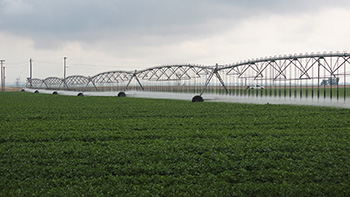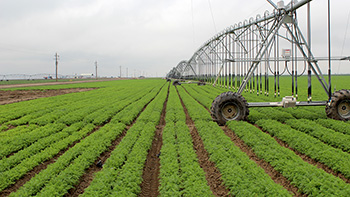
Farmers have several options to choose from when it comes to irrigating large agricultural fields efficiently. One such option that is often overlooked is the linear irrigation system.
Below, we describe what a linear irrigation system is, how it works, its advantages, and how it compares to the more traditional center pivot irrigation. So, if you're a farmer looking to make an informed decision about your irrigation methods, read on to discover the benefits of linear irrigation.
What is a Linear Irrigation System?
A linear move irrigation system is a mechanized method of delivering water to crops in a straight line. It's particularly well-suited for rectangular or square-shaped fields. The system consists of a series of pipe spans, typically supported by wheeled towers, that move back and forth across a field. These spans have sprinklers on top or drop hoses or drip emitters to distribute water evenly across the crop.
How Do Linear Irrigation Systems Move?
Linear irrigation systems, also referred to as lateral systems, move laterally across the field. Typically, electric motors or hydraulic turbines power the movement by driving the wheels on the towers. These wheels are synchronized to ensure the entire system moves in a straight line, covering the whole field's width. The system's design enables it to move at a consistent speed, allowing for precise control over water application. After the system crosses the entire field, it then reverses direction and moves back toward the start. Linear irrigation systems can also be equipped with GPS guidance systems to ensure accurate movement.
How Does Linear Irrigation Work?
 Linear irrigation systems deliver a controlled amount of water directly to the crops. Water is typically ditch-fed from a canal or hose fed from a hydrant and flows through the mainline pipe. As the linear move irrigation system slowly advances, it dispenses water through the sprinklers or drip emitters to cover up to 98 percent of a square or rectangular field.
Linear irrigation systems deliver a controlled amount of water directly to the crops. Water is typically ditch-fed from a canal or hose fed from a hydrant and flows through the mainline pipe. As the linear move irrigation system slowly advances, it dispenses water through the sprinklers or drip emitters to cover up to 98 percent of a square or rectangular field.
Farmers can adjust the speed of the linear system based on factors such as soil type, crop requirements, and weather conditions to ensure effective water distribution. This flexibility allows them to optimize water usage.
What is the Difference Between Linear and Pivot Irrigation?
Linear irrigation and center pivot irrigation are both effective methods for irrigating small or large fields, but they have some key differences:
1. Movement Pattern:
- Linear Irrigation: Moves laterally in a straight line, covering a square or rectangular area.
- Center Pivot Irrigation: Rotates around a central pivot point, covering a circular area.
2. Field Shape:
- Linear Irrigation: Best suited for small or large square or rectangular fields. Depending on the water feed, a swing-around of the system can also irrigate L-shaped fields. Flat fields work best.
- Center Pivot Irrigation: Works well over large square circular or irregularly shaped fields. Though flat fields work best, systems can be designed to accommodate elevation changes within the field. Corner systems can help irrigate the triangular areas outside the circle coverage
3. Water Efficiency:
- Linear Irrigation: Allows for consistent water distribution across the entire crop.
- Center Pivot Irrigation: Employs different nozzle sizes to control the flow from the sprinklers based on their location along the pivot to ensure controlled water application across the field.
Benefits of Linear Irrigation Systems
1. Precise Water Distribution: Linear irrigation systems offer excellent control over water application, helping ensure crops receive the right amount of moisture.
2. Versatility: These systems are adaptable to different field shapes, making them suitable for various farming setups.
3. Consistent Water Application: Because the systems apply the same amount of water from each outlet, they are ideal for chemigation and fertigation to help facilitate higher yields. These systems are suitable for lower-rate water application, which avoids field runoff.
4. Higher Crop Yield: Linear irrigation systems are often used on higher-value crops where precise water application is critical.
5. Labor Savings: Mechanized linear systems require far less manual labor than flood, side roll, or hand-move irrigation methods.
Conclusion
Linear irrigation systems are a valuable alternative to center pivot irrigation for farmers looking to maximize water efficiency and crop yield. Their ability to provide precise water distribution and over 98 percent of the field makes them a wise choice for modern agriculture. As you consider your irrigation options, remember the benefits of linear irrigation systems and how they can contribute to your farming success.

